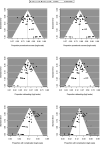Endovascular embolization for the treatment of epistaxis: Systematic review and meta-analysis
- PMID: 35238666
- PMCID: PMC10152829
- DOI: 10.1177/15910199221081715
Endovascular embolization for the treatment of epistaxis: Systematic review and meta-analysis
Abstract
Background: Endovascular embolization (EE) is a treatment option for epistaxis refractory to first-line interventions. Data regarding embolization is limited to small case series and a meta-analysis has not been performed.
Methods: PubMed, Scopus, and EMBASE were used to identify studies that reported outcomes for at least 10 patients undergoing EE for epistaxis. Outcomes included procedural success, rebleeding, and complications. Pooled rates for each outcome were obtained with random effects models.
Results: A total of 44 studies comprising 1664 patients met the inclusion criteria. The mean age ranged from 28.1 to 67 years and there were 28.4% females. The pooled procedural success rate was 87% (95% CI 83.9-89.6, I2 = 53%). Age (OR 0.95, 95% CI 0.91-1) and hereditary hemorrhagic telangiectasia ([HHT], OR 0.97, 95% CI 0.96-0.99) were associated with decreased odds of success. The pooled rebleeding rate was 16.4% (95% CI 13.6-19.6, I2 = 48%), and HHT was associated with greater odds of rebleeding (OR 1.02, 95% CI 1-1.03). The pooled overall complication rate was 14.4% (95% CI 9.8-20.6, I2 = 85.8%). The pooled rates of stroke and vision loss were 2.1% (95% CI 1.5-3.1, I2 = 1.5%) and 1.8% (95% CI 1.2-2.6, I2 = 0%), respectively.
Conclusion: EE for epistaxis has a high rate of procedural success. Interventionalists should be aware of the risk for rebleeding, especially among patients with HHT.
Keywords: Epistaxis; endovascular procedures; therapeutic embolization.
Conflict of interest statement
The author(s) declared no potential conflicts of interest with respect to the research, authorship, and/or publication of this article.
Figures







Similar articles
-
Sclerotherapy for Hereditary Hemorrhagic Telangiectasia-Related Epistaxis: A Systematic Review.Ann Otol Rhinol Laryngol. 2023 Jan;132(1):82-90. doi: 10.1177/00034894221078075. Epub 2022 Feb 12. Ann Otol Rhinol Laryngol. 2023. PMID: 35152768
-
Hereditary hemorrhagic telangiectasia-related epistaxis: innovations in understanding and management.Int Forum Allergy Rhinol. 2012 Sep-Oct;2(5):422-31. doi: 10.1002/alr.21046. Epub 2012 May 7. Int Forum Allergy Rhinol. 2012. PMID: 22566463
-
Risk-reducing bilateral salpingo-oophorectomy in women with BRCA1 or BRCA2 mutations.Cochrane Database Syst Rev. 2018 Aug 24;8(8):CD012464. doi: 10.1002/14651858.CD012464.pub2. Cochrane Database Syst Rev. 2018. PMID: 30141832 Free PMC article.
-
Antioxidants for male subfertility.Cochrane Database Syst Rev. 2022 May 4;5(5):CD007411. doi: 10.1002/14651858.CD007411.pub5. Cochrane Database Syst Rev. 2022. PMID: 35506389 Free PMC article.
-
Return to sport following navicular stress fracture: a systematic review and meta-analysis of three hundred and fifteen fractures.Int Orthop. 2021 Oct;45(10):2699-2710. doi: 10.1007/s00264-021-05147-6. Epub 2021 Aug 20. Int Orthop. 2021. PMID: 34415421 Free PMC article.
Cited by
-
Surgical Management of Moderate to Severe Epistaxis in Hereditary Hemorrhagic Telangiectasia: Systematic Review and Meta-Analysis.Am J Rhinol Allergy. 2025 Mar;39(2):159-168. doi: 10.1177/19458924241308952. Epub 2024 Dec 29. Am J Rhinol Allergy. 2025. PMID: 39906953 Free PMC article.
-
Epistaxis Treatment Options: Literature Review.Indian J Otolaryngol Head Neck Surg. 2023 Sep;75(3):2235-2244. doi: 10.1007/s12070-023-03824-z. Epub 2023 May 8. Indian J Otolaryngol Head Neck Surg. 2023. PMID: 37636777 Free PMC article.
-
Endovascular Embolization for Epistaxis: A Single Center Experience and Meta-Analysis.J Clin Med. 2023 Nov 7;12(22):6958. doi: 10.3390/jcm12226958. J Clin Med. 2023. PMID: 38002574 Free PMC article. Review.
-
Embolotherapy of Head and Neck Lesions: Basics and Clinical Tips.Interv Radiol (Higashimatsuyama). 2024 Oct 4;9(3):112-121. doi: 10.22575/interventionalradiology.2024-0017. eCollection 2024 Nov 1. Interv Radiol (Higashimatsuyama). 2024. PMID: 39559806 Free PMC article. Review.
-
[Uncontrollable nosebleeds on the right : Medical examination: Preparation for ENT specialisation Part 34].HNO. 2025 May;73(Suppl 1):13-17. doi: 10.1007/s00106-025-01608-1. Epub 2025 Apr 1. HNO. 2025. PMID: 40167655 German. No abstract available.
References
Publication types
MeSH terms
LinkOut - more resources
Full Text Sources
Miscellaneous

